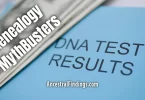If you get your DNA tested, chances are you will come across the term “haplogroup.” What is a haplogroup and how does it pertain to your family history? At its essence, a haplogroup is an ancestral clan. Some clans are the Vikings, Native Americans (all tribes), Celts, Aboriginal Australians, and other such groups. Your haplogroup tells you where your ancestors came from deep back in time.
There are also male and female haplogroups, so you can see where your male and female sides of the family originated back in pre-historic times. As with Y-DNA (which traces the male line from father to son) and mtDNA (which traces the female line from mother to daughter), haplogroups also follow straight male and female descendancy lines.
Your haplogroup’s point of origin is usually shown on maps at the various DNA companies that do testing. Your haplogroup will appear in the area your clan was located when it split off from the original African family to which we all belong.
Initially, there was only one haplogroup, and it was in Africa. As African tribes moved off the continent and went to various other places on the planet, their DNA mutated and the number of haplogroups increased. New haplogroups are formed even today when a gene mutation occurs in someone from a particular ancestral clan. However, it takes generations for enough people to carry the mutation for it to be prevalent enough for it to be considered a haplogroup. Therefore, any haplogroups that start forming today will not be recognized as new ones for centuries. The haplogroups that form today will eventually be able to be traced back to the earliest known person to carry the mutation, just as today’s known haplogroups can be traced back to the earliest known person to carry it in the distant past (though we don’t know the names of these people, we do know they existed and approximately where they lived and when).
Just as new haplogroups are being formed today, many have died out over the course of human history. The haplogroups that exist today originated with people whose descendants were very successful at reproducing in large families.
Haplogroups today are divided into four main ones: European, African, Native American, and Asian. Within these haplogroups are many sub-haplogroups that further define where a person’s earliest known non-African ancestor on the male and female sides of their family originated and when. Most haplogroup sub-groups are plentiful. The only group with less than three sub-groups is the Native American male group, which only has two sub-groups.
Basically, haplogroups chart the clans from which the modern human race originated. Haplogroups are names alphabetically in order of discovery. So don’t assume a haplogroup of A means African or E is European, because this is not true. The sub-groups of haplogroups are named with letter and number combinations indicating where and when in time they were discovered, which main haplogroup they descend from, and sometimes even the very specific small geographical area where their earliest members lived.
The more letters and numbers in your haplogroup’s sub-group, the more likely you are to be able to pinpoint an exact region, and maybe even a county or town. Some haplogroup sub-groups can even be traced back to named individuals if the mutation that created them originated in the more recent past. For example, the infamous Celt, Niall of the Nine Hostages, is known to be the originator of a sub-group of a haplogroup within the past 1500 years, and some people can use their sub-group to prove their descent from him. However, haplogroups are not normally used to prove descent from any one person, just to show you where your “out of Africa” ancestors originated and when.
Right now, haplogroups are the only way to trace your family tree back to the time before surnames were invented. You can take your last known ancestor in a particular direct male or direct female line and connect them to a larger clan in the more distant past, knowing that their ancestors, the ones you can’t identify and trace, wound back through time to the time and place where the known ancestor’s haplogroup and sub-group originated. For example, there is a known haplogroup of people who originated in France, and who are widely believed to be the people who made the famous cave paintings in the French town of Chauvet. You can look at a maternal or paternal haplogroup and sub-group and see if it matches with the haplogroup and sub-group of the cave painters. If it does, you know you are descended from this illustrious and famous group of people.
If you are interested at all in where your family originated deep in time, before the age of records, then haplogroups should be of great fascination for you. While you can’t use a haplogroup to connect to individual people in most cases, you can use them to get deep into history with your family tree. This is something that was not possible before the age of DNA testing.






